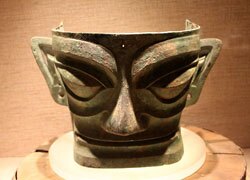Yangtze Culture Evolution
Throughout the ages, Yangtze River has been at the heart of Chinese history. Yangtze has witnessed the solemnity of many Dynasties ranging from the Qin Dynasty and the Han Dynasty to the Tang Dynasty and the Song Dynasty. Historical traces showcasing human activities in Yangtze River dates back to 2 million years ago.
During the autumn and spring of between 770 and 476 BC, the Shu and Ba tribes of China lived near the river’s middle reaches which is present day Sichuan Province. The Chu tribe lived in the lower river reaches which are present day Anhui, Jiangxi, Hunan and Hubei provinces. The Yue and Wu tribes settled at Yangtze River Delta area, present day Shanghai, Zhejiang and Jiangsu.
Due to the difficulties involved in crossing Yangtze River, it was easy for the kingdoms to maintain their borders which were hot spots for fierce battles. The Republic of China and a number of dynasties had Nanjing as their capital. Nanjing was the first bridging area on the river which gave it a strategic advantage. Yangtze culture is today the undisputed cradle for ancient Chinese culture.
Yangtze culture
 Yangtze River features a rich cultural heritage such as the well known hanging coffins on the Gorges, Ghost City of Fengdu and the cave of three travelers. Else where on River Yangtze, upper reaches house minority communities like Naxi of Yunnan and Tibetans with their settlements in the mountainous remote areas. Bashu Culture is embraced on the upper reaches of the river; the middle reach bears Jingchu culture while Wuyue Culture is well featured along the lower River reaches.
Yangtze River features a rich cultural heritage such as the well known hanging coffins on the Gorges, Ghost City of Fengdu and the cave of three travelers. Else where on River Yangtze, upper reaches house minority communities like Naxi of Yunnan and Tibetans with their settlements in the mountainous remote areas. Bashu Culture is embraced on the upper reaches of the river; the middle reach bears Jingchu culture while Wuyue Culture is well featured along the lower River reaches.
Generally, Yangtze River culture is characterized by the Buddhist holy sites like Mt. Emei and the Giant Buddha, ancient towns, a relaxed and peaceful pace of life and the fertile alluvial plains along the river where fishing and agriculture were practiced. All in all, Yangtze culture features Bashu Culture, Jinagchu Culture, Wuyue Culture and Liangzhu culture as highlighted below:
Bashu Culture
 The Ba is a reference to Chongqing while Shu represents Sichuan. As such, the Bashu Culture is a combination of regional culture in Chongqing and Sichuan, includes also minority cultures in surrounding regions. Bashu Culture has for years been an integral aspect of Chinese culture and its history dates back to the Neolithic Age.
The Ba is a reference to Chongqing while Shu represents Sichuan. As such, the Bashu Culture is a combination of regional culture in Chongqing and Sichuan, includes also minority cultures in surrounding regions. Bashu Culture has for years been an integral aspect of Chinese culture and its history dates back to the Neolithic Age.
The Sanxingdui Museum houses archeological discoveries of the ancient Shu and acts as a proof of the bronze and glorious jade of Bashu Culture. In geographical terms, Bashu refers to a basin land that was secluded from the rest of the world due to difficulties in transportation. Thanks to these unfavourable conditions, local industrious tribes developed ways of communicating with the rest of the world. They laid planks on the cliffs and fought their way which is today an important aspect of the inclusive and open Bashu culture.
Jingchu Culture
Geographically, Jingchu denotes Hubei province that was the cultural, political and economic center of the traditional Chu state. As such, Hubei province boasts of being the birthplace of Jingchu culture. It comprises of several sub- cultures such as Shennnong and Emperor Yan Culture, Qin, Chu State, the three kingdoms culture, Han, the Three Gorges Culture, Qingjiang Batu Culture, Wuhan Culture and the well known Temples and Mountain culture.
On the material aspects of Jingchu culture, you will find fine handcrafts like embroidery works and silk materials, exquisite woodworks, lacquer and bronze wares. There are also the folk customs like worship, sacrifice, chime bell, poetry and unique songs and dancing styles. Terraced buildings and palaces also had a unique architecture.
Wuyue Culture
Largely centered on Taihu Lake, the Wuyue Culture has largely influenced Eastern Anhui, northeastern Jiangxi, Shanghai, Zhejiang and Jiangsu provinces today. Centered on a charming landscape which is its ideal environment, Wuyue culture is delicate and fine where people have great respect for talent and also emphasize on the importance of education.
Wuyue Culture endows people who have a pioneering spirit and largely stresses on locals surpassing themselves, being brave to dare and be the first and no fear in trying new things. Lastly, Wuyue Culture advocates for human virtues of trustworthiness and honesty, kindness and pragmatism. These are the aspects that make Wuyue Culture very unique compared to other Chinese regional cultures.
Liangzhu culture
Dating back to about 5000 years ago, Liangzhu culture is largely associated with Taihu Lake Valley, which is a downstream stream of Yangtze River. Archeological studies show that Liangzhu culture was largely based on agriculture and great specialization in handcraft. Additionally, Liangzhu culture is believed to have pioneered the carving industry. Archeologists uncovered many large jade ritual objects in Taihu Lake Valley that are today used in Chinese ceremonies. Liangzhu culture sites are believed to be a holy land that demonstrates modern day Chinese civilization.
Today, along the banks of Yangtze River, you can admire the historic relics such as those in Zhou, Shang and Xia. The cultural relics and ancient architecture has made cruising Yangtze Rive not only something to be admired by people who appreciates the natural beauty of the river but also those who want to learn about the long history of Yangtze River and its glorious culture.
For travelers wishing to appreciate religious architecture relics, the best choice is Shibaozhai. Visitors who wish to admire stone carving relics are advised to visit White Crane Ridge- Baiheliang. Strolling among the crucial historic relics and pondering the historical background of this place will make your Yangtze River trip a valuable and memorable vacation.
You may also be interested in Yangtze Culture as below:



